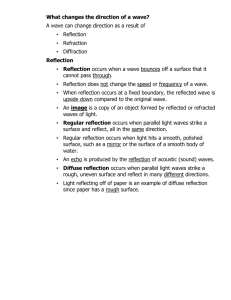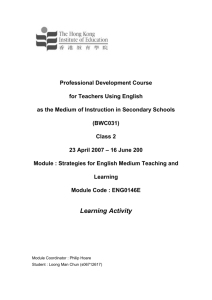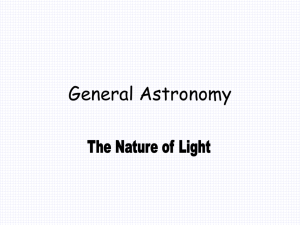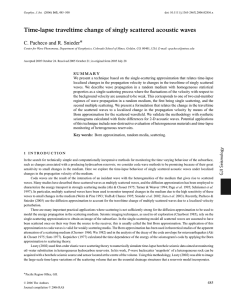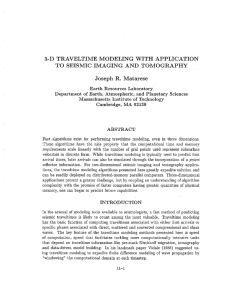Geol4068 Reflection Seismology
advertisement
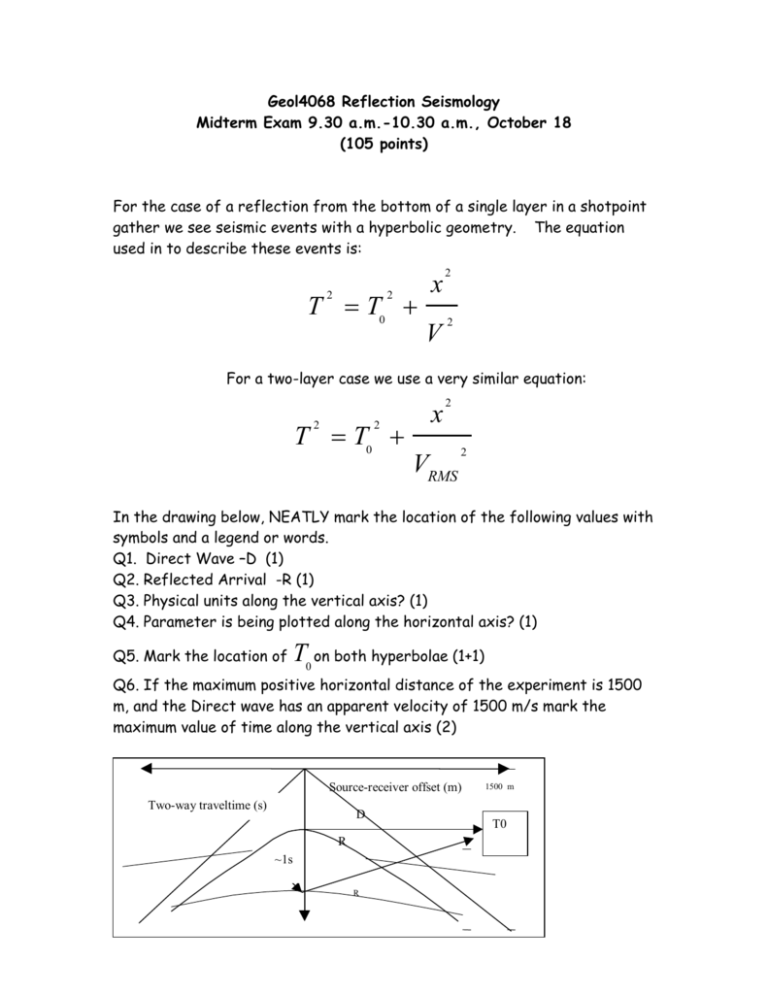
Geol4068 Reflection Seismology Midterm Exam 9.30 a.m.-10.30 a.m., October 18 (105 points) For the case of a reflection from the bottom of a single layer in a shotpoint gather we see seismic events with a hyperbolic geometry. The equation used in to describe these events is: T T0 2 2 x 2 V 2 For a two-layer case we use a very similar equation: T T0 2 2 x 2 VRMS 2 In the drawing below, NEATLY mark the location of the following values with symbols and a legend or words. Q1. Direct Wave –D (1) Q2. Reflected Arrival -R (1) Q3. Physical units along the vertical axis? (1) Q4. Parameter is being plotted along the horizontal axis? (1) Q5. Mark the location of T0 on both hyperbolae (1+1) Q6. If the maximum positive horizontal distance of the experiment is 1500 m, and the Direct wave has an apparent velocity of 1500 m/s mark the maximum value of time along the vertical axis (2) Source-receiver offset (m) Two-way traveltime (s) D R ~1s R R 1500 m T0 Q7. Why do we use Vrms in a two-layer case and not just V average? (2) Vrms approximates the first term in the mathematical series that is used to represent traveltime events for earth models with two or more layers. Vaverage is a valid substitute for Vrms only for a single-layer, homogeneous, earth model. Q8. List the possible reasons that the hyperbola is not centered at the shotpoint (x=0 m) (5) 1500 m (1) Interface dipping to the right, or diffractor. Q9. List as many differences between a surface wave and a body wave as you can. (5) Surface wave- Sh Love only or retrograde elliptical Rayleigh particle motion. Surface waves need a free boundary. Their amplitude decays away from the surface of the earth and with distance travelled. P-wave has particle motion inline, away or toward direction of wave propagation . S-wave can have Sh or Sv particle motion. Amplitude decays with distance travelled. Surface waves travel at slower speeds than body waves. Q10. Give one application of the Reciprocity Theorem? (5) Interchange of source and receivers around a culturally sensitive target. Q11. What is anisotropy? Give an example. (5) Variation of physical property with direction, e.g. Vp. Q12. What is the difference between diffraction and refraction? Give an example of each. (5) Diffraction is the scattering of rays/waves in all directions from a relatively small (point) reflector. Refraction involves bending of waves/rays when they cross between layers of different physical properties. Q13 What is the difference between a diffraction hyperbola and a reflection hyperbola? Show with an illustration. (10) Very little if the reflection is from a dipping interface. Q14. What does fold mean in the CMP method? Give an example. (5) Number of times a point in the subsurface is sampled by any shot and receiver pair. Q15. Who wrote a seminal paper on the subject of the CMP method? (5) (bonus points) Harry Maynes Q16. Name the basic assumption of the CMP method? (5) Reflection point lies half way between receiver and source in the subsurface, but this is only possible if the layering is horizontal, there is isotropy and the velocity field is homogeneous within each layer. Q17. What is responsible for a second Fresnel Zone? (10) In the general sense: expanding wavefront. Source wavelet shape can control appearance of second important Fresnel zone. Q18. What's a head wave? Draw one on a source-receiver offset versus traveltime plot. (5) Critically refracted ray along interface travelling at velocity of the medium immediately below the interface. Q19. What are the two advantages of the CMP method over previous methods? (10) Greater S/N, minimizes effects of subsurface dip, and allows this all while permitting roll-along. Q20. List all the multiple types you know. Name at least two. (10) Short-path (e.g. source and receiver ghosts) and long-path (e.g. sea-bottom multiples) Q21. In the top-left following diagram what phenomenon causes the reflection coefficient to have a value close to 1? (10) Total internal Reflection



